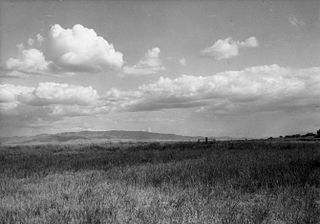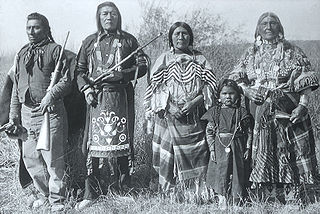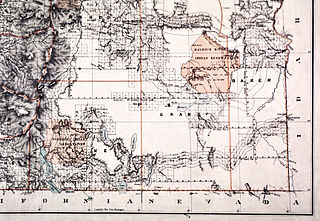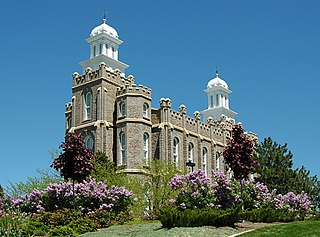
Bannock County is a county in the southeastern part of the U.S. state of Idaho. As of the 2010 United States Census the population was 82,839, making it the fifth-most populous county in Idaho. The county seat and largest city is Pocatello. The county was established in 1893 and named after the local Bannock tribe. It is one of the counties with territories included in the Fort Hall Indian Reservation of the federally recognized Shoshone-Bannock Tribes.

Larry J. Echo Hawk is an attorney, legal scholar and politician. In 2012, he was named as a general authority of The Church of Jesus Christ of Latter-day Saints. On May 20, 2009, Echo Hawk joined the administration of U.S. President Barack Obama as the United States Assistant Secretary of the Interior for Indian Affairs. He previously served as the elected Attorney General of Idaho from 1991 to 1995, being the first Native American elected to that position. He also served two terms in the State House of Idaho.
The Shoshone or Shoshoni are a Native American tribe with four large cultural/linguistic divisions:

Fort Hall was a fort that was built in 1834 as a fur trading post by Nathaniel Jarvis Wyeth. It was located on the Snake River in the eastern Oregon Country, now part of present-day Bannock County in southeastern Idaho, United States. Mr. Wyeth was an inventor and businessman from Boston, Massachusetts, who also founded a post at Fort William, in present-day Portland, Oregon, as part of a plan for a new trading and fisheries company. Unable to compete with the powerful British Hudson's Bay Company, based at Fort Vancouver, in 1837 Wyeth sold both posts to it. Great Britain and the United States both operated in the Oregon Country in these years.

The Fort Hall Reservation is a Native American reservation of the federally recognized Shoshone-Bannock Tribes in the U.S. state of Idaho. This is one of five federally recognized tribes in the state. The reservation is located in southeastern Idaho on the Snake River Plain about 20 miles (32 km) north and west of Pocatello. It comprises 814.874 sq mi (2,110.51 km2) of land area in four counties: Bingham, Power, Bannock, and Caribou. To the east is the 60-mile-long (97 km) Portneuf Range; both Mount Putnam and South Putnam Mountain are located on the Fort Hall Reservation.
The Bannock War of 1878 was an armed conflict between the U.S. military and Bannock and Paiute warriors in Southern Idaho and Northern Nevada, lasting from June to August 1878. The Bannock-Paiute totaled about 500 warriors; they were led by Chief Buffalo Horn who was killed in action in June. After his death, Chief Egan led the Bannock. He and some of his warriors were killed in July, by an Umatilla party who entered his camp in subterfuge.

The Bannock tribe were originally Northern Paiute but are more culturally affiliated with the Northern Shoshone. They are in the Great Basin classification of Indigenous People. Their traditional lands include northern Nevada, southeastern Oregon, southern Idaho, and western Wyoming. Today they are enrolled in the federally recognized Shoshone-Bannock Tribes of the Fort Hall Reservation of Idaho, located on the Fort Hall Indian Reservation.

Fred Thomas Dubois was a controversial American politician from Idaho who served two terms in the United States Senate. He was best known for his opposition to the gold standard and his efforts to disenfranchise Mormon voters.
Richard Watkins, born in 1962, is a horn player. He performs as a concerto soloist and chamber music player. He was Principal Horn of the Philharmonia Orchestra from 1985 to 1996, a position he relinquished to devote more time to his solo career.
Jacob Spori was the first principal of the Bannock Stake Academy, an institution that would eventually become Brigham Young University–Idaho.
Pocatello, Idaho, has been home to baseball teams who have competed in 35 seasons of Minor League Baseball, between 1926 and 1993.

The Malheur Indian Reservation was an Indian reservation established for the Northern Paiute in eastern Oregon and northern Nevada from 1872 to 1879. The federal government "discontinued" the reservation after the Bannock War of 1878, under pressure from European-American settlers who wanted the land, a negative recommendation against continuing it by its agent William V. Rinehart, the internment of more than 500 Paiute on the Yakama Indian Reservation, and reluctance of the Bannock and Paiute to return to the lands after the war.

The Pocatello Metropolitan Statistical Area, as defined by the United States Census Bureau, is an area consisting of Bannock and Power counties in eastern Idaho, anchored by the city of Pocatello. As of the 2010 census, the MSA had a population of 82,839. Power County was added back to the Pocatello MSA as of April 10, 2018.

The Lemhi Shoshone are a tribe of Northern Shoshone, called the Akaitikka, Agaidika, or "Eaters of Salmon". The name "Lemhi" comes from Fort Lemhi, a Mormon mission to this group. They traditionally lived in the Lemhi River Valley and along the upper Salmon River in Idaho. Bands were very fluid and nomadic, and they often interacted with and intermarried other bands of Shoshone and other tribes, such as the Bannock. Today most of them are enrolled in the Shoshone-Bannock Tribes of the Fort Hall Reservation of Idaho.
Ezra Christensen Dalby (1869–1934) was the president of the Bannock Stake/Ricks Academy from 1901 to 1914.

The Bannock War of 1895, or the Bannock Uprising, refers to a minor conflict centered on Jackson's Hole, Wyoming, in the United States. During the early 1890s Wyoming passed a state law prohibiting the killing of elk for their teeth, which led to the arrests of several Bannock hunters in 1895. The arrests, and the death of one Bannock, created wildly exaggerated rumors that the natives would revolt, and the Eastern press reported that the Bannocks had massacred a large group of settlers in Jackson's Hole. In response the United States Army launched an expedition into the area, but when troops arrived it was found that the situation was peaceful and the fears of uprising were unjustified.

Northern Shoshone are Shoshone of the Snake River Plain of southern Idaho and the northeast of the Great Basin where Idaho, Wyoming and Utah meet. They are culturally affiliated with the Bannock people and are in the Great Basin classification of Indigenous People.
Charles Watkins may refer to:

Cyrus Y. Jacobs was a grain mill owner, distiller, and merchant in Boise, Idaho. He served as mayor of Boise City 1879-1880.














